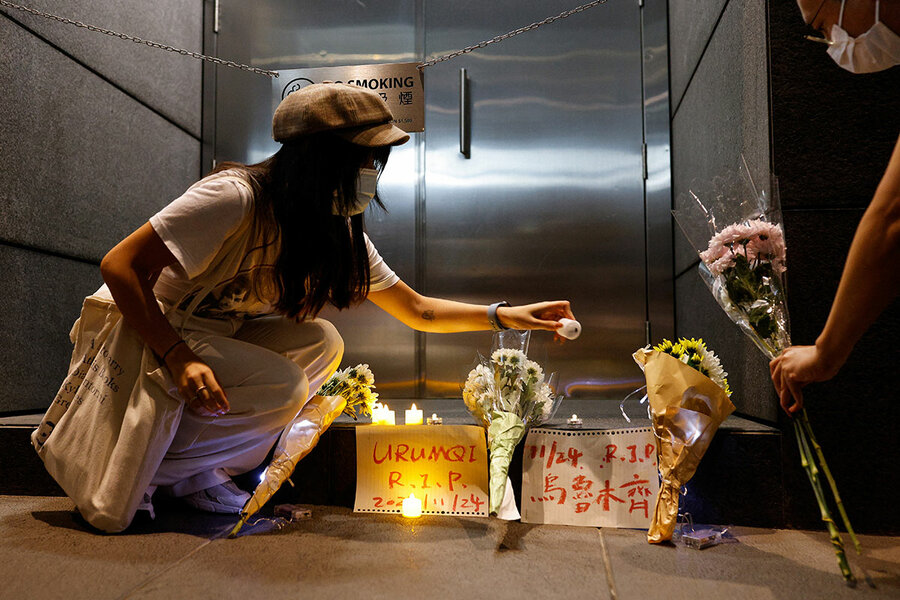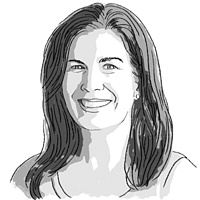‘A new situation’: After protests, China relaxes COVID restrictions
| Beijing
A small crowd of Beijing residents gathered on an ancient lane in the city’s Chaoyang District, arguing with workers who were building a 10-foot-tall corrugated metal fence to seal off their neighborhood last week amid a rapid surge in COVID-19 cases.
Workers were walling off multiple routes inside the maze of alleys known as hutongs, restricting population movement and causing mini traffic jams of bicycles, motorbikes, delivery carts, and cars as they tried to squeeze through the few narrow outlets.
“It’s because of the outbreak!” a woman said with exasperation, walking away after residents failed to stop the blockage. “We can still get out on another lane,” another woman said with resignation.
But all the freshly built barricades in the neighborhood were suddenly dismantled after popular frustration erupted in rare nationwide protests in Beijing and other cities over China’s strict “zero-COVID” policies last weekend. “It’s strictly forbidden to use hard partitions and hard fences to block fire exits and community entrances,” stressed Wang Daguang, Beijing’s official in charge of community COVID-19 prevention, on Monday.
The about-turn is one of several small but meaningful steps taken by Beijing and other cities in the aftermath of the protests to relax the stringent policy of lockdowns, quarantines, and constant testing that has grown ever more intrusive amid a record COVID-19 outbreak in China. It demonstrates how popular opposition can propel change in the authoritarian country, as it has over other public concerns such as air pollution and food safety in recent years.
“It appears that even the central government overestimated people’s ability to endure all the pain,” says Yanzhong Huang, director of the Center for Global Health Studies at Seton Hall University. “Given the rising social discontent … I don’t think the [zero-COVID-19] approach can be sustained that long.”
From Beijing to Guangzhou, a “new situation”
One of the clearest signs that the public outcry is helping drive a shift in policy came this week when China’s top official in charge of COVID-19 controls, Vice Premier Sun Chunlan, suggested the pandemic’s danger is waning, creating a “new situation” for China.
“With the weakening of the … Omicron virus, the popularization of vaccination, and the accumulation of prevention and control experience, China is facing a new situation and new tasks in epidemic prevention and control,” Ms. Sun said in a meeting with China’s National Health Commission on Wednesday, according to the state-run Xinhua News Agency.
“We must … take small steps, without stopping,” she said, signaling a gradual but steady loosening of COVID-19 requirements. In a notable change in tone, Ms. Sun didn’t mention the official term for China’s “zero-COVID” policy, also known as “dynamic clearing,” in the Xinhua report.
While softening its tone, the central government has also put the onus for the lockdowns on localities, experts say.
“They are doing a couple of things at once that are both responsive to the public frustration about the zero-COVID: announcing some loosening of the restrictions, but at the same time blaming local officials for being too rigid in how they are implementing them,” says Bruce Dickson, professor of political science and international affairs at George Washington University.
Across the country, Beijing, Guangzhou, and other cities until recently had been tightening their lockdowns and building new quarantine shelters. But despite facing major outbreaks by Chinese standards, cities that saw protests are now moving swiftly to lift or modify restrictions that have made life especially difficult for residents.
Beijing this week has begun to allow people who contract COVID-19 and their close contacts to quarantine at home instead of forcing them to go to hospitals or warehouselike makeshift quarantine centers. It has allowed certain groups of people – including older residents, people working from home, and students studying online – to stop getting routine COVID-19 tests every 48 hours. It’s also reopening some shopping malls.
The southern city of Guangzhou, which saw a string of major protests, has opened up several locked-down districts, stopped mass testing, and allowed close contacts of people with COVID-19 to quarantine at home. It also began allowing people to eat in restaurants again rather than order takeout.
Shift in messaging
Another important change is that Chinese epidemiologists and other experts have begun downplaying the risks of COVID-19 – signaling an effort by the government to tamp down fear among a public that has so far been warned to avoid the virus at all costs.
The weakening of COVID-19 variants “reminds us not to panic,” Lan Ke, director of a research team from a government virology laboratory at Wuhan University, was quoted as telling the state-run Global Times newspaper. “For ordinary people, the damage caused by coronavirus has markedly diminished compared to the original strain.”
In some ways, this shift in official messaging is catching up with mainstream Chinese views, experts say. Awareness has grown among ordinary Chinese that the rest of the globe has moved on from the pandemic and fully opened up – underscored by television broadcasts here of maskless fans filling stadiums at the World Cup soccer tournament.
On China’s Twitter-like microblogging website Weibo, the lack of masks at the World Cup in Qatar has been a hot topic in recent days. “The World Cup gave a vivid political lesson on epidemic prevention,” wrote one person. “It is certain that the epidemic prevention policy will be adjusted after the World Cup.”
“We as a whole are more connected than ever, and this is absolutely true of Chinese citizens,” says Jennifer Hsu, research fellow in the Public Opinion and Foreign Policy Program at the Lowy Institute. “Three years on, there is that frustration” among Chinese as they watch “fellow citizens around the world … [gathering] without masks on.”
To be sure, even as Chinese authorities ease restrictions in response to public pressure, they could reassert them if cases and deaths begin to spiral, experts say.
“The health care issues favor maintaining some kinds of controls … but the economic and political considerations suggest loosening them – so they are working at cross purposes,” says Dr. Dickson, author of “The Party and the People: Chinese Politics in the 21st Century.”
For the time being, though, residents of Beijing’s Chaoyang District neighborhood are breathing a little easier. “Having the streets blocked was pretty inconvenient,” says Zhao, a shopkeeper, withholding her first name. “Things are better now.”






